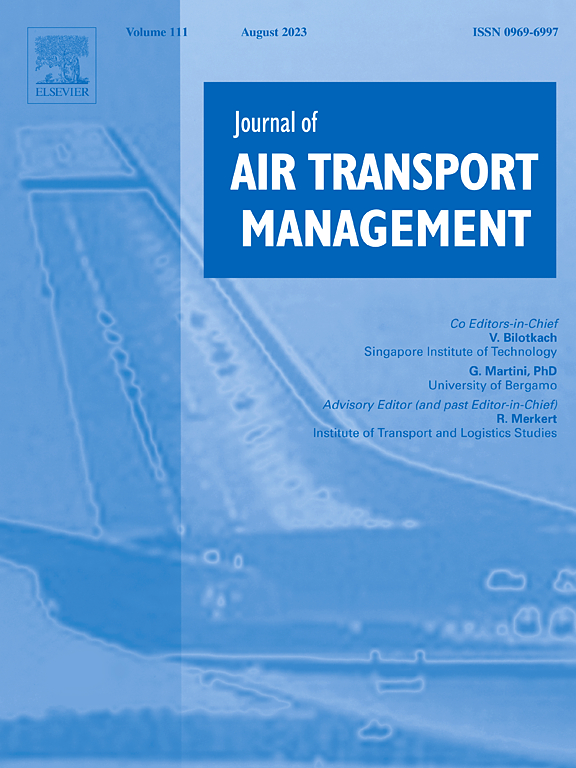Effects of connection time on connected itineraries in Indian domestic aviation market
IF 3.6
2区 工程技术
Q2 TRANSPORTATION
引用次数: 0
Abstract
Connected air itineraries are an integral part of air travel. There is a mixed perception among passengers regarding connections at an intermediate airport as they present a range of difficulties, such as the chances of missing a flight, and loosing or delaying of checked-in baggage. In addition, operational issues (long inter-terminal transfers, inadequate availability of intra-airport shuttle services, delays in baggage check-in, etc.) at the airports also cause inconvenience to passengers using connected itineraries. One of the critical backend procedures to provide uninterrupted and efficient air travel for passengers is the provision of minimum connection time (MCT) at an airport for an itinerary with a connection, which is vital for flight operations. There have been discussions on the amount of time spent for a connection, and the conventional belief that passengers favour short connection times is widespread among air travellers. This study aims to analyse this hypothesis for domestic air itineraries by using a revealed preference data collected in India. A multinomial logit (MNL) specification with correction for price endogeneity is adopted to model airline itinerary choice of passengers. A recursive method in MNL is used to dynamically create the utility function to handle large and varying alternatives. For alternative choice set generation, actual (real) alternatives available to passengers are used in the MNL model. A piecewise linear specification is used to address the non-linearity of the connection time for direct itineraries (includes a stop, with no plane change) and connected itineraries (includes a stop, with a plane change). Results reveal that there is a positive influence of connection time on utilities up to 120 min for connected itineraries. The connection time duration of 90–120 min for connected itineraries is found to provide maximum utility to flyers, balancing the need for sufficient time to navigate transitions such as security checks and gate changes, while minimizing the inconvenience of extended waiting periods. For direct itineraries a connection time beyond 35 min is found to reduce the utility substantially on direct itineraries. To understand the economic significance of the connection time, the willingness to pay estimates are evaluated and validated by estimating confidence intervals using Monte Carlo simulations using a truncated normal distribution. Findings reveal that flyers are willing to pay INR 14 (USD 0.16) per minute up to 90 min and INR 30 (USD 0.36) per minute for reductions beyond 120 min for connected itineraries. In contrast, for direct itineraries, passengers are willing to pay INR 2.8 (USD 0.03) per minute for layovers up to 35 min and INR 66 (USD 0.77) per minute for reductions beyond 35 min. This paper provides insights regarding the willingness to pay for each additional minute on a connection, thereby can help carriers to schedule their connections and provide adequate connection times for various airports based on the potential mix of air passengers.
印度国内航空市场转机时间对转机行程的影响
互联航线是航空旅行的重要组成部分。乘客对中转机场的看法不一,因为中转会带来一系列困难,比如可能错过航班、丢失或延误托运行李。此外,机场的运营问题(航站楼间转乘时间长、机场内班车服务不足、行李办理延误等)也给使用联程行程的旅客带来不便。为乘客提供不间断和高效的航空旅行的关键后端程序之一是为有转机的行程在机场提供最短转机时间(MCT),这对航班运营至关重要。人们一直在讨论转机所花费的时间,而乘客喜欢缩短转机时间的传统观念在航空旅客中普遍存在。本研究旨在通过使用在印度收集的显示偏好数据来分析国内航空行程的这一假设。采用一种考虑价格内生性修正的多项logit (MNL)规范对旅客的航线选择进行建模。在MNL中,采用递归方法动态创建实用函数来处理大量且变化的备选项。对于备选选择集的生成,在MNL模型中使用乘客可用的实际(真实)备选方案。分段线性规范用于解决直达行程(包括一个停站,不改变平面)和连接行程(包括一个停站,改变平面)连接时间的非线性。结果表明,连接时间对连接线路的效用有正向影响,最长可达120分钟。90-120分钟的连接时间为旅客提供了最大的效用,平衡了足够的时间来完成安检和登机口变更等过渡,同时最大限度地减少了长时间等待带来的不便。对于直达航线,连接时间超过35分钟会大大降低直达航线的效用。为了了解连接时间的经济意义,通过使用截断正态分布的蒙特卡罗模拟估计置信区间来评估和验证支付意愿估计。调查结果显示,乘客愿意在90分钟内每分钟支付14卢比(0.16美元),而在120分钟以上的联程航班上,乘客愿意每分钟支付30卢比(0.36美元)。相比之下,对于直达航线,乘客愿意为35分钟内的转机支付每分钟2.8印度卢比(0.03美元),为35分钟以上的转机支付每分钟66印度卢比(0.77美元)。本文提供了关于转机每多一分钟付费意愿的见解,从而可以帮助航空公司安排转机,并根据潜在的航空乘客组合为各个机场提供足够的转机时间。
本文章由计算机程序翻译,如有差异,请以英文原文为准。
求助全文
约1分钟内获得全文
求助全文
来源期刊

Journal of Air Transport Management
TRANSPORTATION-
CiteScore
12.40
自引率
11.70%
发文量
97
期刊介绍:
The Journal of Air Transport Management (JATM) sets out to address, through high quality research articles and authoritative commentary, the major economic, management and policy issues facing the air transport industry today. It offers practitioners and academics an international and dynamic forum for analysis and discussion of these issues, linking research and practice and stimulating interaction between the two. The refereed papers in the journal cover all the major sectors of the industry (airlines, airports, air traffic management) as well as related areas such as tourism management and logistics. Papers are blind reviewed, normally by two referees, chosen for their specialist knowledge. The journal provides independent, original and rigorous analysis in the areas of: • Policy, regulation and law • Strategy • Operations • Marketing • Economics and finance • Sustainability
 求助内容:
求助内容: 应助结果提醒方式:
应助结果提醒方式:


